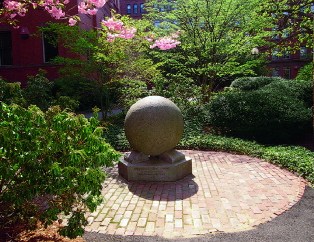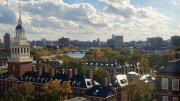The United Fruit Company planted huge quantities of bananas in Costa Rica in the 1930s. Workers clearing tropical forests in the Diquís Delta, in the country's hot, humid southwest, found in the underbrush numerous stone balls. The original purpose of the balls--and more than 300 of them exist, from a few inches in size to a whopper more than eight feet in diameter--is a mystery.
John W. Hoopes, Ph.D. '87, an anthropologist and associate professor at the University of Kansas, says that the balls "were most likely made about 1,400 to 1,800 years ago. They remained in use for a long time, probably until a.d. 1000, being moved around--to the tops of hills or to islands off the coast--and rearranged."
The balls are perfectly round and usually have polished surfaces. They are of a hard igneous rock called granodiorite. "This material has a fracture pattern somewhat like that of an onion," says Hoopes. "By successive use of heat (building a fire on the stone) and cold (dashing it with cold water), a person could reduce an irregular boulder to a sphere. The greater amount of labor appears to have gone into grinding and polishing."
The ball shown here is three feet, seven inches, in diameter and is said to weigh 2,000 pounds. It was one of two such balls sent in 1964 by the National Museum of Costa Rica to the Central American pavilion at the New York World's Fair. At the conclusion of the fair, one of the balls went to the National Geographic Society and the other to the Peabody Museum at Harvard. (Reportedly, many other Costa Rican antiquities also left the country for good during the 1960s.)
The director of Costa Rica's National Museum in 1964 was Doris Zemurray Stone '30. She was a distinguished archaeologist and ethnographer and a benefactor of the Peabody in many ways. She was also the daughter of Samuel Zemurray, president of United Fruit until his retirement in 1951. Hoopes recalls that when he was a graduate student, the ball was known jokingly at the Peabody as the "Doris Stone."
The banana planters removed the balls from the forest with little notice taken of their locations. Scholars might have been able to see that the positions had significance, perhaps in astronomical observations. Hoopes believes that "the making and moving of the balls was probably an important social activity, perhaps more important than possession of the finished product." The people who made them lived in conical houses with thatched walls and foundations of rounded river cobbles. "We believe that the balls may have sat in front of the houses of prominent people, perhaps as a display of power, of esoteric knowledge, or of control over labor," says Hoopes. Thus, Harvard's ball, in a courtyard by the Peabody Museum, may even now be fulfilling its original function as lawn ornament.






